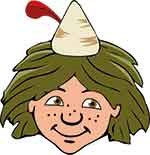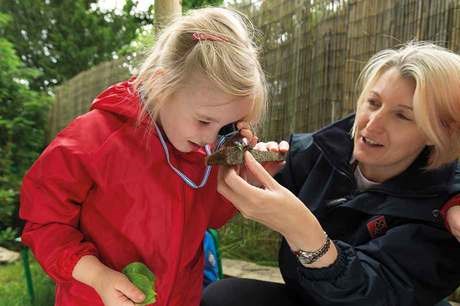Enabling Environments: Outdoors - Call of the wild
Nicole Weinstein
Monday, February 6, 2017
A forest creature who teaches respect for nature is capturing young children’s curiosity around the world. Nicole Weinstein reports

 Skogsmulle is a Swedish early years pedagogy, based on a fictional forest creature of that name and designed to encourage young children to experience, explore and respect nature.
Skogsmulle is a Swedish early years pedagogy, based on a fictional forest creature of that name and designed to encourage young children to experience, explore and respect nature.
Skogsmulle (‘forest creature’) wears a little green hat and a big smile and accompanies children in the woods, where he sings with them, plays with them and tells them stories about nature.
He is the steward of nature and has captured the hearts and minds of thousands of children in Sweden and around the world.
The approach was developed in the 1950s by Gösta Frohm, while working for Sweden’s Association for Promotion of Outdoor Life. Skogsmulle, or Mulle – who was born on a farm in Botkyrka, Sweden – is central to the approach and he is usually presented to children in the form of a puppet, or leaders dress up as the character.
His suit is green like moss; his wig grey-brown like lichen. He wears peaked shoes and a hat of birch bark with a red feather, while his tail is made of roots, so that he can sweep the ground. Home for him is a hut in the forest; ‘Hej kollikok’ is his call.
Since its inception, the approach has been developed by parents’ groups and nurseries in Sweden and beyond, and embraced as a means of delivering an inspirational, holistic and child-centred approach to achieving the early years curriculum. Skogsmulle is often used as a provocation to spark children’s curiosity and encourage them to observe nature more closely, to learn about the plants and animals and to love and respect the natural world.
While Mulle remains central to the approach, he has along the way acquired three friends. Fjällfina, who came 15 years later, introduces children to mountains and high places; Laxe helps children learn about water, while Nova is an alien from an unpolluted planet similar to Earth. The additional characters were created by Gosta Frohm and practitioners involved with the Skogsmulle movement, as part of the wider Friluftsfrämjandet Organisation.
AROUND THE WORLD
Skogsmulle was officially launched in the UK in July 2015, with a training course in South Wales, Manchester and Scotland. Running the course were the founders of the first nursery to embed the Skogsmulle concept in Sweden in 1985, in partnership with Welsh outdoor training company Ignite UP and early years consultants Juliet Robertson and Rose Joyce.
Since the establishment of the first I Ur och Skur or ‘Rain or Shine’ nursery – the name given to Swedish nurseries that adopt the Skogsmulle approach – more than two million Swedish children have learnt to appreciate and care for nature.
Today there are more than 200 I Ur och Skur nurseries and five primary schools. However, there are also many parent-run weekend groups, along with other groups for different ages. Skogsmulle is also embedded in Finland, Norway, Germany, Latvia, Russia and Japan.
Since becoming the first Skogsmulle leader in Wales in 2011, Darren Lewis of Ignite UP has developed Skogsmulle parent-and-toddler sessions at Dare Valley Country Park in Aberdare. He says, ‘It is still niche in the UK but interest is growing. Several countries have “imported” Skogsmulle, and some, like Japan and Latvia, have taken differing routes towards making it successful in terms of it translating into their cultures and education system. There are now 30 qualified Skogsmulle leaders in the UK, ten of whom are practising it on a sessional basis or embedding it into their curriculum. In Wales, we are successfully putting practitioners into local mainstream primary schools and delivering short ten-week sessions to raise awareness of Skogsmulle.’
TARGET AUDIENCE
Children are usually introduced to Mulle at the age of three or four, but he is directed primarily at children aged five and six – the age at which children most readily engage with fantasy characters.
‘I call this the Santa Claus effect,’ says Juliet Robertson, who specialises in outdoor learning. ‘Children aged five to six years tend to accept Santa Claus as really existing. Before this age, some children can be a little frightened of a fantasy character. Beyond this age, children are less likely to believe and know that it’s someone dressing up. So, what the Skogsmulle character says and does has particular resonance for five- and six-year-olds.’
The approach, she argues, is ‘ideal’ for helping children make the transition between Reception and Year 1, but is also ‘significantly deeper’ in purpose and practice than just using puppets outdoors. ‘The common misunderstanding,’ she adds, ‘is to look at just the work with five- to six-year-olds, rather than in the context of a life-long progression of sustainable outdoor experiences.’
CASE STUDY
Children aged three to six are now taking part in tailored Skogsmulle sessions at Dame Allan’s School, a private setting in Newcastle.
Early years teacher Gill Williams trained to become a Skogsmulle leader at Sweden’s original Rain or Shine forest school in September last year and has since been embedding the philosophy into the school’s curriculum.
‘It’s early days but the children have really taken to it and are spellbound by Mulle. We’ve always done outdoor learning at the school and we have a small, dedicated forest site, where the children spend time exploring nature and the outdoors. The older children enjoy fires and working with tools but I wanted something more imaginative and creative for our younger children.
‘During the training, we learnt all about the theory and history of Skogsmulle and about the Swedish culture and heritage, where there is a strong passion for outdoor learning. One of the statements that sticks with me is the theory for the countryside, “If you learn to love something you will cherish it.”
‘The whole Skogsmulle pedagogy encourages children to learn about the outdoors and have respect for it. What struck me is their knowledge at naming trees and plants and how everything is done in a calm way. Also, the children are given so much more responsibility. The two- and three-year-olds packed their own bags for the day with no fuss – and no-one is weather-obsessed. It’s just accepted that they go outside come rain or shine.
‘In bringing back the theory to the UK, we have taken the values that they have from the woodlands and forest and tried to implement them, focusing on how the children relate to our countryside. For example, this term we went on an autumn walk and instead of just bringing back the conkers, we discussed the finer details of the trees. We talked about the changing trees and the colours and how some trees have needles and leaves.
‘I introduced Mulle to the children in September. I explained that I’d been on a lovely trip and I showed them where Sweden was on the map and we talked about the seasons and the snow. I told them that I’d brought back a very special friend who knows a lot about the Swedish countryside but would like to know more about ours.
‘The children decided that they would like him to stay and they are learning to love him. They react immediately to his special call and I can hear them say, “Mulle is calling us”. We keep it solely for use in the woods. They also love the song that goes with it.
‘The children, particularly those aged five to six, believe that he is actually a creature from the woods and they empathise with the fairy tale behind him. They want to bring him things from the wood: show him berries; collect sticks for him and talk to him about wildlife.
‘For me, the course has changed my planning to incorporate more time for exploration. The dedicated Skogsmulle sessions are more successful because I have a greater understanding of what children want to learn and how they can enjoy being in the woods.
‘My advice for anyone considering going on the course is to go for it and to not be put off by the fact you are going to a country where outdoor learning takes place in all weather. What you learn can be adapted. It’s flexible and you can pitch it to all settings and children.’
MORE INFORMATION
Juliet Robertson’s training company, http://creativestarlearning.co.uk
Outdoor Learning Past and Present by Rose Joyce (Open University Press) includes a chapter on Skogsmulle, http://owlscotland.org/images/uploads/cluster_groups/Skogsmulle_and_his_friends.pdf
2017 International Skogsmulle Symposium, at Dare Valley Country Park in Wales (4-6 August), marks Skogsmulle’s 60th birthday. Go to www.igniteup.co.uk or email info@igniteup.co.uk





